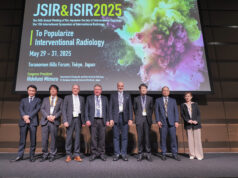 “We aim to help interventional radiologists become masters of the live image,” says Tom Boeken (Hôpital Européen Georges Pompidou, Paris, France) describing the purpose of his team’s—six mathematical researchers— artificial intelligence (AI) lab specifically geared toward solving interventional radiology (IR) “problems”.
“We aim to help interventional radiologists become masters of the live image,” says Tom Boeken (Hôpital Européen Georges Pompidou, Paris, France) describing the purpose of his team’s—six mathematical researchers— artificial intelligence (AI) lab specifically geared toward solving interventional radiology (IR) “problems”.
Boeken and colleagues have been working on using geometry to develop AI systems for procedural assistance. “One of our key areas is geometry and how it can aid interventional radiologists in their day-to-day procedures,” Boeken shares with Interventional News.
In the specialties adjacent to IR, AI has been successfully implemented, Boeken explains. Diagnostic radiology, for example, has “robust AI tools for pre- and post-procedural phases of treatment, as well as for prediction models in patient selection, like identifying features on an MRI [magnetic resonance imaging] or early follow-up imaging,” he says. “While all of this is interesting to interventional radiologists, it’s not unique to our field. These models can apply to surgery, chemotherapy and radiation therapy.”
“What is truly unique to IR, is our use of real-time imaging during interventions,” Boeken pinpoints. “Our focus on this, we hope, will empower our community in differentiation to other specialties that use imaging.”
Boeken and his research team are mainly working on two subtopics: 3D imaging and 2D and angiographic imaging and are set to discuss their progress during the ‘AI in IR: Pre, post and intraprocedural prediction models’ session hosted by SPHAIRE (Spotlight on AI and emerging technologies in IR)—a dedicated area for emerging technologies at this year’s Cardiovascular and Interventional Radiological Society of Europe (CIRSE) annual congress (13–17 September, Barcelona, Spain).
Their work on 3D imaging looks at procedures such as thermal ablation, exploring how to guide a needle into a tumour, optimise margins, avoid damaging surrounding organs and eventually incorporate robotics. In 2D angiography, Boeken describes that his team are developing automation tools to better understand flow in vascular interventions—“like predicting which catheter will reach the target most effectively and supporting device deployment decisions”.
Prediction models using advanced statistics for IR procedures have become increasingly commonplace and have been successfully used in large studies such as the COLLISION trial. To Boeken, however, this doesn’t necessarily spell progress yet, as “globally, we’re still working to prove that our treatments are worth doing”, he says.
“Take liver ablation. Despite being performed for decades, we still must justify treating a 2cm tumour without surgery, so trials like COLLISION are crucial for our field and show that prediction models can help by improving outcomes through better patient selection. This way we can increase acceptance of our treatments. That’s the value of pre-procedural AI,” Boeken details.
On the other hand, there are “drawbacks” to using AI for patient selection, he describes, one being the risk of becoming too selective, treating only the patients these models predict will respond well. “In the past, companies have sought perfect trial results and therefore only treated patients most likely to respond,” Boeken opines. He states that this has left many treatable patients excluded from trials in which they may have benefitted.
In Boeken’s view, it’s vital that interventionists continue to treat patients who might not have a high predicted success rate but who also have no other options: “If an AI model suggests a low probability of response, but the alternative is decline, we should still consider intervention,” says Boeken. He explains that, in the recruitment of trials, AI solutions have been used in debatable ways to improve efficiency and lower costs. Using pharmaceutical trials as an example, Boeken details how AI models can identify centres that are likely to underperform in recruitment and exclude them, even if there are patients who could be referred.
For some companies, Boeken shares that it is favourable to recruit fewer patients for financial reasons while ensuring that those who are enrolled meet stringent inclusion parameters which may indicate better treatment outcomes. Alternatively, he describes a branch of AI that can help to generate “fake” or synthetic data to bulk out clinical trial findings by enlarging a dataset for statistical purposes even if a small number of patients are recruited.
“As much as I’d like to have warnings concerning AI use in clinical trials, AI can also help interventional radiologists run clinical trials today,” Boeken says. “For instance, if five expert centres can only recruit 30–40 patients, synthetic data can help grow these data artificially and still be viable from a scientific perspective.”
“Our datasets are very small, and they will always be small. We’re not cardiologists that have 10,000-patient datasets or oncologists with 20,000 patients in a breast cancer screening programme. AI can really help our community be more scientifically credible and visible,” Boeken avers. “So, we must think differently about AI. Instead of relying on massive datasets, we’re building tailored models based on geometry and other mathematically structured methods.”
Thinking differently, Boeken and his team recently published the Checklist for Artificial Intelligence Research Evaluation (iCARE) to map a clearer pathway for AI’s use in IR research.
“We’ve gone pro,” Boeken states. “We were lacking a common direction. [Using iCARE], we’ve moved from a mindset of ‘AI is interesting’ to being able to conduct structured scientific research harnessing it—it’s very cool,” he says.










